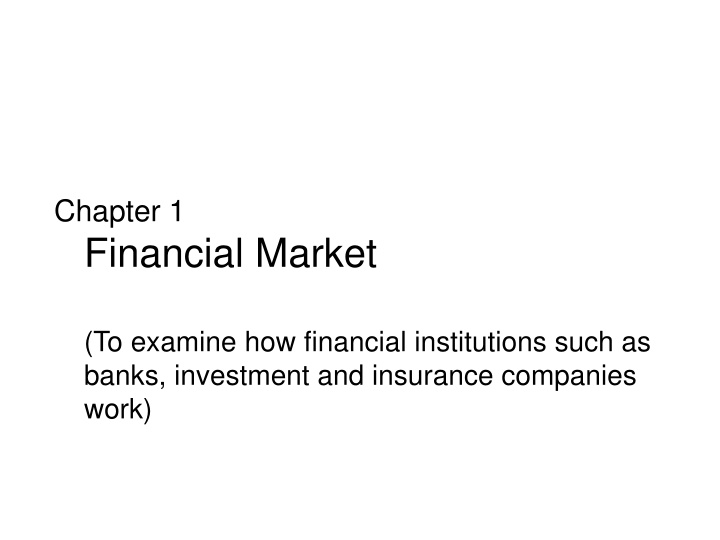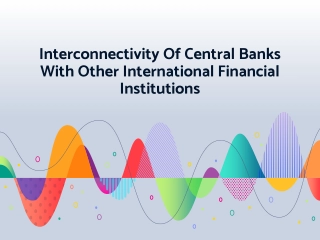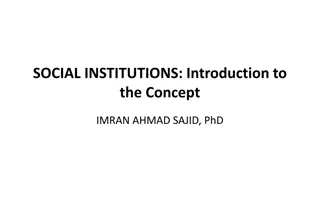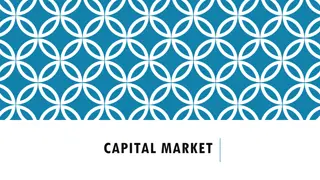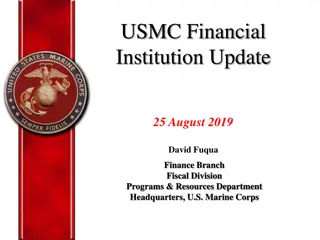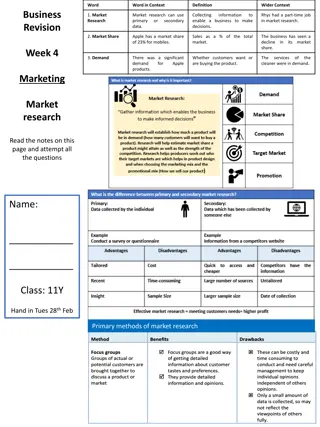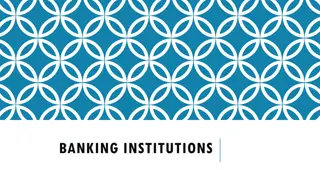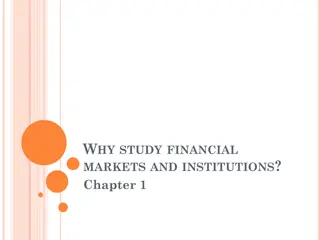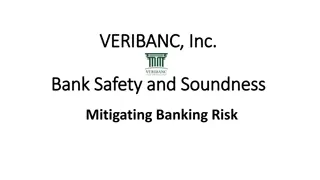Financial Market Dynamics and Institutions
Explore the role of financial markets, banking, and institutions in the economy, from understanding financial intermediation to the impact of financial crises. Delve into the significance of bonds, stocks, and innovations shaping the global financial landscape.
Download Presentation

Please find below an Image/Link to download the presentation.
The content on the website is provided AS IS for your information and personal use only. It may not be sold, licensed, or shared on other websites without obtaining consent from the author.If you encounter any issues during the download, it is possible that the publisher has removed the file from their server.
You are allowed to download the files provided on this website for personal or commercial use, subject to the condition that they are used lawfully. All files are the property of their respective owners.
The content on the website is provided AS IS for your information and personal use only. It may not be sold, licensed, or shared on other websites without obtaining consent from the author.
E N D
Presentation Transcript
Chapter 1 Financial Market (To examine how financial institutions such as banks, investment and insurance companies work)
Learning Objectives Recognize the importance of financial markets in the economy. Describe how financial intermediation and financial innovation affect banking and the economy. Explain the importance of exchange rates in a global economy.
Financial Markets Financial markets are markets in which funds are transferred from people and firms who have an excess of available funds to people and firms who have a need of funds
The Bond Market and Interest Rates A security (financial instrument) is a claim on the issuer s future income or assets. A bond is a debt security that promises to make payments periodically for a specified period of time. An interest rate is the cost of borrowing or the price paid for the rental of funds.
The Stock Market Common stock represents a share of ownership in a corporation. A share of stock is a claim on the residual earnings and assets of the corporation.
Figure 2 Stock Prices as Measured by the Dow Jones Industrial Average, 2012 2020
Why Study Financial Institutions and Banking? (1 of 2) Financial intermediaries: institutions that borrow funds from people who have saved and in turn make loans to people who need funds. Banks: accept deposits and make loans Other financial institutions: insurance companies, finance companies, pension funds, mutual funds and investment companies Financial innovation: the development of new financial products and services e.g., the improvement of information technology leads to the ability to deliver financial services electronically (e-finance)
Why Study Financial Institutions and Banking? (2 of 2) Financial innovation: the development of new financial products and services Can be an important force for good by making the financial system more efficient E-finance: the ability to deliver financial services electronically Financial crises: major disruptions in financial markets that are characterized by sharp declines in asset prices and the failures of many financial and nonfinancial firms.
Why Study Money and Monetary Policy? Evidence suggests that money, defined as anything that is generally accepted as payment for goods or services or in the repayment of debts, plays an important role in generating business cycles. Recessions (unemployment) and expansions affect all of us. Monetary theory ties changes in the money supply to changes in aggregate economic activity and the price level.
Money, Business Cycles, and Inflation The aggregate price level is the average price of goods and services in an economy A continual rise in the price level (inflation) affects all economic players Data show a connection between the money supply and the price level NOTE: Visit www.tradingeconomics.com for latest data/charts
Fiscal Policy and Monetary Policy Monetary policy is the management of the money supply and interest rates Conducted in the SBP Fiscal policy deals with government spending and taxation Budget deficit is the excess of expenditures over revenues for a particular year Budget surplus is the excess of revenues over expenditures for a particular year Any deficit must be financed by borrowing
Figure 7 Government Budget Surplus or Deficit as a Percentage of Gross Domestic Product, 1995 2019
The Foreign Exchange Market The foreign exchange market: where funds are converted from one currency into another The foreign exchange rate is the price of one currency in terms of another currency. The foreign exchange market determines the foreign exchange rate.
Why Study International Finance Financial markets have become increasingly integrated throughout the world. The international financial system has tremendous impact on domestic economies: How a country s choice of exchange rate policy affect its monetary policy? How capital controls impact domestic financial systems and therefore the performance of the economy? Which should be the role of international financial institutions like the IMF?
Figure 8 Exchange Rate of the PKR against USD, 2010 2020 Source: https://www.xe.com/currencycharts/?from=USD&to=PKR&view=10Y
The International Financial System Financial markets have become increasingly integrated throughout the world. The international financial system has tremendous impact on domestic economies: How a country s choice of exchange rate policy affect its monetary policy? How capital controls impact domestic financial systems and therefore the performance of the economy? Which should be the role of international financial institutions like the IMF? (Will discuss in later Chapters)
